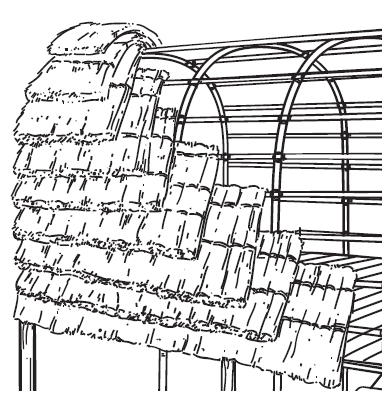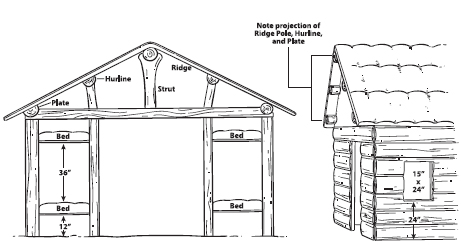
Hoop design on a shelter configuration
The best type of permanent shelter depends on the environment, seasonal changes, resources available, equipment on hand, and the skill level of the user. Here we will discuss a few simple designs that do not require vocational expertise. In my experience, anything that is too difficult or complicated to construct is likely to be left undone.
Long before man started constructing his own shelter he adopted existing elements in nature to be his home, just as animals do. These caves and stone shelters endure in nature, and although it takes a little effort to make them comfortable, they can still be a great choice if the situation arises. In fact, there are millions of people worldwide who live in cave dwellings.
It is important to remember the dangers that may present themselves in natural dwellings.
A wet cave can be a miserable place to sleep. If you are in an area with high humidity or lots of annual rainfall, caves are not the best choice. Cave moisture creates several dangers, including bacteria growth, mold, weak stone integrity of the cave itself, and a dampness that could leave you cold most of the time. A cave might also already be home to insects and other mammals such as bats, cats, or bears.
If you are considering using a cave as a permanent shelter dwelling, inspect it for signs of animals that may have set up housekeeping. Look for feces, bones, and smells of urine. Falling rock can also present a danger, so make a visual inspection with a good light source of the ceiling and walls. Look for fissures or cracks in the stone that might be compounded by heat from a fire. Consider the height of the ceiling. The lower the ceiling height of the cave, the more a fire will affect the structure’s integrity. Caves with higher ceilings will also provide much better ventilation.
A raised platform shelter can be constructed by attaching wood pieces with simple lashings and cross members to create the platform. Just remember that the more complex the shelter, the more resources and tools that are required to construct it. The raised platform should be at least 3'–5' above ground level; again, this depends on the factors like wildlife, resources, and environment. Make this platform at least 2' wider than the inside dimension of the shelter you plan to place on top of it and at least 6' longer to leave room for open work areas. The covering or construction of the shelter itself can be a simple hoop design or a square structure. The hoop design is by far the easiest to build and maintain, and it will shed water the best as well.

Hoop design on a shelter configuration
Building a small cabin with a single pitched roof is a fairly simple undertaking from a design perspective. However, it is labor-intensive and requires a great deal of timber resources. An 8' × 10' cabin should be sufficient for a single person. Anything larger will be difficult to heat. You will want logs of at least 8"–10" diameter for this, and size will dictate the number needed.

Basic log cabin design